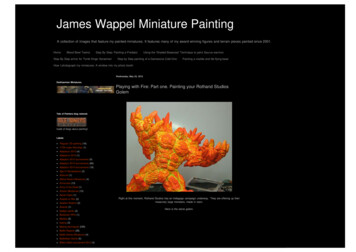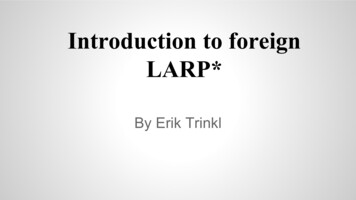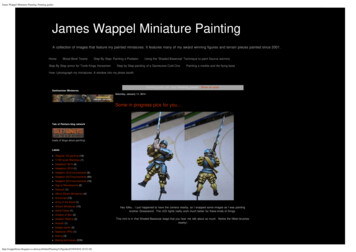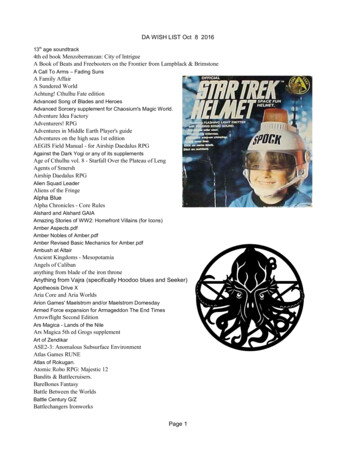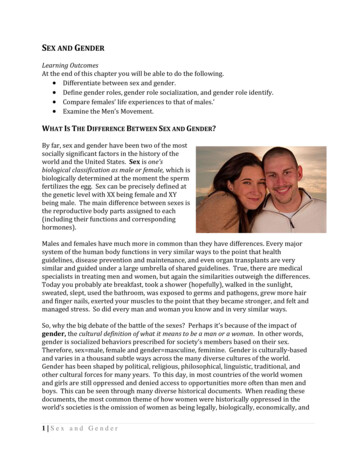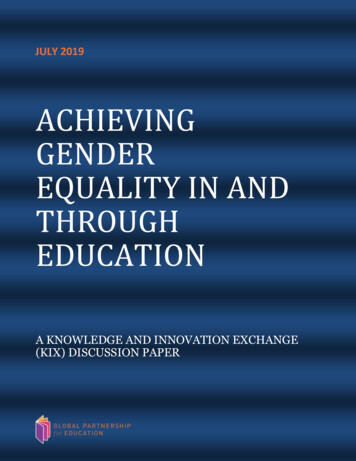
Transcription
AWEJ for Translation & Literary Studies volume, 1 Number 2, May2017Pp. no2.10Gender Stereotypes in Fantasy Fairy Tales: CinderellaAbir El ShabanLanguage, Literacy and TechnologyDepartment of Teaching and LearningCollege of Education, Washington State UniversityPullman, Washington, USAAbstractThis paper explores gender stereotypes and culture depicted in three different versions ofCinderella children textbooks. The researcher has limited the study of fairy tales to Cinderella,the western version that she grew up reading it, and two other eastern versions: The EgyptianCinderella and The Korean Cinderella. The characteristics of all versions represent differentethnics and cultural backgrounds. Findings that are based on discourse analysis show that thecriteria of beauty and stereotype vary among all of the three versions of Cinderella childrentextbooks. That variation is based on the perspective of the culture represented in each one of thestories. Some valuable educational implications to limit the stereotypical gender misconceptionsin children literature are presented to both parents and teachers.Key words: children books; children literature; fairy tales; fantasy; gender; stereotypesCite as: El Shaban, A. (2017). Gender Stereotypes in Fantasy Fairy Tales: Cinderella. ArabWorld English Journal for Translation & Literary Studies, 2.10Arab World English Journal for Translation & Literary StudieseISSN: 2550-1542 www.awej-tls.org123
AWEJ for Translation & Literary Studies volume, 1 Number 2, May 2017Gender Stereotypes in Fantasy Fairy Tales: CinderellaEl Shaban1. IntroductionLiterature plays a very important role in the maturity of our knowledge and understanding of life.It is mostly a reflection of our societies. Many scholars, such as Botelho and Rudman (2009),agree that gender, race, class and many other ideologies are implicitly and explicitly representedin many of children’s literature and more precisely in fantasy fairy tales. Thus, they maynegatively contribute in the creation of our children’s values and attitudes and impact theirviewpoints of the real life. Therefore, some educators have criticized many of the fairy tales fortheir negative influences on children. They have explicitly portrayed stereotypical concepts aboutwomen such as being passive, beautiful, week, sexy and dependent or cruel, tough, selfish andjealous etc. For instance, Ms. Lurie (1970) points out that many of the European fairy talesmisrepresent women. She claims that such stories only “reflect the taste of the refined literarymen who edit the first popular collections of fairy tales during the Victorian era” (as cited inLieberman 1972, p. 383). Furthermore, Lieberman (1972) criticizes fairy tales for perpetuatingwomen as “passive, submissive and helpless” (p.387). It is very rare when fairy tale storiesportray women as active and non-passive. However, in this study, the author will highlight fewpoints that contradict the above generalizations.1.1 Purpose of the StudyThe author has chosen to limit the study of fairy tales to Cinderella, the western versionthat she grew up reading it, and two other eastern versions. They are The Egyptian Cinderellaand The Korean Cinderella. The characteristics of all the versions represent different ethnics andcultures. Even though, there is an estimation of more than one thousand existing versions ofCinderella tales, the criteria of beauty vary among some of them (Botelho& Rudman, 2009, p.225). That is why the author has specifically selected these three versions of Cinderella.Additionally, the author chose the fairy tale Cinderella story in particular because: It is one of the adults and children’s very well known stories,It has various versions of different cultures,Different versions of the story are available in the English language,The researcher is curious to reveal some possible gender stereotypes depicted in thethree different cultural versions of Cinderella, and,The author aims at sharing some valuable educational implications to avoid or at least,to limit the stereotypical gender misconceptions. Furthermore, regardless of itspopularity, this tale in particular, has been criticized in many previous research studies.1.2 What is a Stereotype?Peterson (2004) defines stereotype as “a negative statement made a bout a group ofpeople” (p. 26). In other words, it means applying specific generalization to an entire group ofpeople. This paper aims at revealing the gender stereotypes that are depicted in three children’spicture textbooks. These textbooks are McClintock’s Cinderella, Climo’sThe EgyptianCinderella and Climo’sThe Korean Cinderella. There is an agreement among many educatorsabout the idea that gender stereotypes and the underestimation of females in children’s textbookscan have a great negative influence on children’s behaviors and beliefs. Such influences mightlead children to create false generalizations about the roles of both males and females. Killen,Lee-kim, McGlothlin and Stranger (2002) claim, “In the area of gender, stereotypes have beenviewed as the shared beliefs about the typical characteristics of males and females” (p. 19). InArab World English Journal for Translation & Literary Studies124eISSN: 2550-1542 www.awej-tls.org
AWEJ for Translation & Literary Studies volume, 1 Number 2, May 2017Gender Stereotypes in Fantasy Fairy Tales: CinderellaEl Shabanfact, they have found in a research on stereotype that children start to think about stereotypedknowledge even before they start school. Unfortunately, gender stereotypes can be a reflection ofour cultures’ true values.Historically, regardless of the biological gender differences between males and females,Biklen and Pollard (1993) have claimed that there was a sort of disagreement about the females’nature. There was a debate about whether women’s nurture abilities are better to be found withinfamilies at home or to be competent to men’s jobs and careers outdoors. Gender differences canalso be seen among young and adults in classrooms, at work and sometimes among the membersof the same family. For instance, in education, Sadkers (1990) is surprised of how teachers ofelementary and secondary schools focus more on interacting with boys more than they do withgirls. They listen, reward, criticize and counsel boys more than they do with girls. They relatethis kind of interaction to ethnic and racial related issues. They also note that minority males andfemales are the least to interact with teachers than the mainstream males and females.In work fields, Biklen& Pollard (1993, p. 96), claim that women with academic degreeare less likely to be employed and if they are employed, their allowances are always less than themen. This is the case even if males and females are occupying similar jobs. Furthermore, Sarland(1991) supports Rowbotham argument and relates this marginalization to “gender code” (p. 48)that associates the relations between females and houses and males and outdoor careers.Nevertheless, throughout time women started to gain a social status, develop self-identity andbecame self-dependent rather than relaying on males in providing and proving themselves.Therefore, the author, as a mother and as an educator, believes that it is crucial toapproach and reveal some of these implicitly and explicitly stated stereotypical roles of femalesin multicultural children’s literature. Through us, parents and teachers might be able to helpchildren and students to wear critical lenses when they read different kinds of stories, and helpthem to be aware of the many implicit stereotypical issues.1.3 What is Fantasy?There has been a debate among many educators regarding the exact explanation of theword fantasy. Allen (2005) claims that defining fantasy is similar to “catching fog in a fishingnet”. She explains fantasy by relating it to its opposite meaning, which is reality. Yet she adds,“to say that fantasy is unreal is to imply that it does not exist, and clearly it does”. She explains,“Its worlds drift in and out of our world, always close by, but often only visible to theimagination. Within it are myths, legends, fables, and folklore” (p. 10). Further, Bettelheim(1976) thinks of fantasy and fairy-tales as “spiritual explorations” that show “human life asseen, or felt, or divined from the inside” (p. 24)In most of the English edited Cinderella’s stories, even though, each is from a differentculture such as Cinderella, The Egyptian Cinderella and The Korean Cinderella, they still sharesimilar characteristics of life livings and circumstances (Botelho& Rudman, 2009). Althoughmost of these fairy tales are imaginative ones, they still imply many of the true universalstereotyped concepts regarding good vs. evil, sadness vs. happiness, ugliness vs. beauty andethical vs. unethical. Also, the existence of fairy godmother in the Western fairy tales reflectsArab World English Journal for Translation & Literary StudieseISSN: 2550-1542 www.awej-tls.org125
AWEJ for Translation & Literary Studies volume, 1 Number 2, May 2017Gender Stereotypes in Fantasy Fairy Tales: CinderellaEl Shabanimportant information about that culture. Goodwin (2008) states that in Western cultures likeIreland and Scotland, for instance, if a child found to be miserable, he/ she was asked to look fora fairy godmother to help him/her.Traditionally, it has been widely known that fairy tales have not been written for children.They have been very popular in both public and social gatherings settings, specifically in thetimes that have witnessed the absence of media. During that time, people used to gather ingroups and listen to the teller man whose job is to entertain his audiences saying interestingstories. Zipes (2006) claims, “fairy tale is a polygenetic cultural artifact that has spreadthroughout the world through human contact” (p. xiv).More than half a century ago, fairy tales were full of violence and misfortunate eventssuch as killing, revenge, and rape. These type of tales were meant to be for adults only. Forinstance, Charles Perrault and the German brothers Grimm’s Cinderella are rich of revengescenes that Cinderella commits on her stepfamily. One of these bloody scenes describes howCinderella’s two-step sisters cut their toes to fit their foot into Cinderella’s slipper to marry theprince. A similar violent scene was in the fairy tale snow white. The scene involves a child eatingher stepmother. Such scenarios were popular until the eighteenth century when children literaturestarted to emerge as “chap books, religious tracts, educational pamphlets and folk tales”(Goodwin, 2008). Nevertheless, Goodwin (2008) has added that the real “golden age ofchildren’s literature” was seen after the “Romantic Movement” in the nineteenth century. At thatperiod of time, series of famous stories have started to be published, for example, Alice’sAdventure in Wonder Land was published in 1966 and Peter Pan was published in 1904 (p. 56).As one of the important issues of this paper is to explore stereotypes and gender roles,Killen, Lee-Kim, McGlothlin and Stangor (2002) argue in their book How Children andAdolescents Evaluate Gender and Racial Exclusion that there might be “times when groupsreject individuals for reasons that are wholly external to the social skills or social abilities of theindividual being rejected” (p. 3). They have added that these reasons can be classified as gender,ethnicity, race, religion and social class. Further, Rowbotham, a feminist, (1989) argues thatwomen are marginalized from the mode of production; nonetheless men have a value “in thecash nexus, offering their labor for economic reward”, while as she specifies that, “The women’srole is to reproduce the workforce and service its needs in unpaid capacity” (Sarland, 1991, p.48).Many educators consider beauty so gendered stereotypical concept. Sperry andGrauerholz (2003) examined how the normative feminine beauty ideal is maintained in fairytales. Also, they explored how feminine beauty in the Grimm’s fairy tales is emphasized. Moreimportantly, they question why some fairy tales such as Cinderella and Snow White are survived,while many others are not. Thus, they claim that stories, which heavily emphasize femininebeauty are much more likely to be survived. Furthermore, Bonds-Raake (2006) conducted anempirical research study of the psychological effects of gender stereotypical portrayals in Disneyand fairy tales’ movies, and she realized that she was stereotyped all her life. A point that needsto be highlighted to avoid such a stereotypical issues in depicted in children literature.Arab World English Journal for Translation & Literary StudieseISSN: 2550-1542 www.awej-tls.org126
AWEJ for Translation & Literary Studies volume, 1 Number 2, May 2017Gender Stereotypes in Fantasy Fairy Tales: CinderellaEl ShabanOn the other hand, Strayer (1995) examined the enjoyment and the familiarity of fairytales on forty children and thirty adults who live in North America. Thus, she found out thatchildren love certain genre due to their exposure to it and due to their involvement in imaginativeactivities. Further, her findings show that “the emotions attributed to the story were similaracross child and adult respondents, and similarly affected one’s liking for the tale” (p.1). Also,she states that neither gender consistency nor gender stereotypes has significantly affected eithermales or females liking of the story. Yet, stereotypes consistency influences children’s predictionwhere female-hero would be liked by females and less liked by males.Nevertheless, gender is still there. It can be seen in the blue colored clothes for a newbornboy and pink for a girl. Also, another element that would force the existence of genderstereotypes notions among children, since kindergarten, is the existence of “a cooking corner forgirls and a building-blocks corner for boys” (Biklen& Pollard, 1993, p. 176). Such physicalseparations concerning activities would reinforce the notion of gender differences andstereotypes among boys and girls.2. MethodologyIn this study, the author has selected three children’s picture textbooks that (1) sharesimilar genre, (2) have obedient heroines, (3) have different settings, (4) occur in differentcultures, (5) all are fairy tales, and (6) published between 1989 and 2006. This study aims atexamining the multicultural associations of gender and beauty depicted in these three texts andthe elements of the illustrations among them. Also, the author would like to examine the physicalappearance of the heroines of the three stories as it might be so gender based focusing onattractiveness, hair, skin and eye color.Furthermore, by adopting Botelho and Rudman’s (2008) critical multicultural analysis ofchildren’s literature approach, the author would like to shed the lights on some of the social andideological identities of gender that are depicted in the three children textbooks. Taking intoconsiderations (1) critical reading and examination of the illustrations and (2) finding the genderstereotypical conceptions. The following table shows how the three children textbooks are codedin terms of gender role themes. The X sign indicates that this factor, beauty for example, is eitherimplicitly or explicitly depicted in the textbook. Any column that is free of the X sign indicatesthe absence of that particular factor in that textbook.Table 1. Gender stereotypes of Cinderella, the Egyptian Cinderella and the Korean CinderellaThe Stories’ GenderThemesBeautySex RolesPhysical AppearancePassiveResistanceOpportunistGender DiscriminationClassRaceHeroes HandsomenessLiving Happily EverCinderellaThe Egyptian CinderellaThe Korean CinderellaXXXXXXXXXXXXXXXXXXXXXXXXArab World English Journal for Translation & Literary StudieseISSN: 2550-1542 www.awej-tls.orgXX127
AWEJ for Translation & Literary Studies volume, 1 Number 2, May 2017Gender Stereotypes in Fantasy Fairy Tales: CinderellaAfterGood BeautyEvil UglinessTotalXX10XX13El ShabanXX92.1.Data AnalysisFor the purpose of data collection and analysis, the author relied on book and articlereviews, and searched the Internet to know more about the cultural background of the threechildren textbooks. In analyzing the data, the author adopts Botelho and Rudman’s (2009)critical multicultural analysis of children literature approach. Since they encourage readers to“think about the interplay of race, class, gender in books” (p. ix). Moreover, the author useddiscourse analysis procedure in analyzing the texts of the three textbooks. First, she criticallyread the textbooks. Then, she started coding the statements that represented gender stereotypes ineach of the stories and related each coded text to its matching gender theme as it is shown in thefirst column of table 1. Furthermore, she considered Zipes’ (1986) claim “ To talk about fairytales today, especially feminist fairy tales, one must, in my opinion, talk about power, violence,alienation, social conditions, child-rearing and sex roles” (p. 2). So all of these factors areconsidered as part of data analysis.According to Botelho and Ruman (2009), they argue that most Cinderella stories aresharing a similar genre. However, the majority of them differ from each other in small aspectssuch as the offensive people surrounding the heroines. For instance, in The Persian Cinderella, itis her siblings not her stepfamily that are mistreating her and in The Egyptian Cinderella, theyare the three Egyptian servants. Most of the other heroines are mistreated by their evilstepmother and one or two-stepsisters such as in The Korean Cinderella and the westernCinderella that is related to Perrault’s version.2.2. CinderellaCinderella, the Western,isone of the most famous fairy tales comparing it with Cinderellastories from other ethnics and cultures. Cinderella (2005), by Barbara McClintock, tells a storyabout an obedient innocent girl whose father is a nobleman. She lost her mother at a very youngage and her father decided to marry. Her stepmother was cruel and as a result, she was forced tobe a servant to an evil stepmother and nasty two stepsisters. Finally, this little poor girl, with thehelp of her fairy godmother, regained her affluent status and got married to the kingdom’shandsome prince after he identified that she is the owner of the little sparkling glass slipper thatshe lost after she ran away from the ball.Textual critical analysis of Cinderella has revealed that there are manymisrepresentations of the social feminine roles in this version of Cinderella story. First, itrepresents stepmother and her daughters as evils and has no mercy. Second, the father is sopassive and seems uncaring about his daughter. Third, Cinderella seems to be content with herdestiny for being a servant to her stepfamily. Fourth, the power is in magic. It is what every poorgirl should look for to help her. Fifth, beauty, grace, luxurious dresses are what attract theattention of a royal man. Sixth, Sexism is implicitly stated in the text of this story. All of thesesix negative features can be classified under gender role stereotypes.Arab World English Journal for Translation & Literary StudieseISSN: 2550-1542 www.awej-tls.org128
AWEJ for Translation & Literary Studies volume, 1 Number 2, May 2017Gender Stereotypes in Fantasy Fairy Tales: CinderellaEl ShabanBy examining the stepmother’s aggressiveness with her orphan poor stepdaughter andcomparing it with the way she kindly treats her daughters, educators should be sensible of thepresence of such qualities in children’s textbooks. The author did not indicate even a small signof the stepmother’s well being that might give a hope to children, especially those who live withtheir stepmothers. In this story, the poor Cinderella is experiencing gender and classdiscrimination from her stepfamily. Also, by examining the sentence “Her stepmother ruled herfather with an iron fist, and the poor girl knew he would only scold her if she complained. So shesuffered in patient silent”, it can be determined that such expressions in children’s books wouldabsolutely have negative consequences on children’s perception of stepmothers and the way theyview real life. Moreover, children who live in similar situations in reality, or those who live witheither a stepmother or father might come to their minds that the stepmother might neglect themas it happened to the heroine Cinderella. Even though, that might not be the truth, but this is whattheir little mind would visualize. Although, many scholars such as Lieberman and Zibes havecriticized Cinderella for her passivity, I disagree with them regarding this point. I, personally, seeCinderella as kind and polite more than being completely content and passive. Also, herobedience should be considered strength not weakness. I am sure that she had no choice otherthan being obedient and servant to her stepfamily. How would she resist them in a society wherewomen are totally dependent on men in their families? Let us all imagine if there is a Cinderellain the twenty first century. I am confident that she would be completely resistant and she mightcollude with her oppressors, if she only wanted to keep somehow her relationship with them. Toemphasize such an attitude, children books writers should be cautious of all their implicit andexplicit messages within a textbook.Moreover, in Cinderella story the heroine resisted her stepfamily’s orders when shefound someone who can help her to make her wish come true. In fact, she went to the ball,danced with the prince with no fear. Further, she invited her stepfamily to taste the oranges thatthe prince gave her as a gift. Also, “Cinderella smiled a secret smile”, when her stepsistersrefuted to lend her an old dress to go with them to the ball in the next day. Her smile implies thatshe will go to the ball without their permission. She will do what her desire tells her to do. Infact, passive people lack this feature. Cinderella, in my opinion, is an absolute opportunist.Furthermore, she dared to ask the prince’s valet to try the slipper and more importantly, sheconfidently showed them her other pair of the shoes. The author views Cinderella’s life sequenceas lucky, beautiful, unlucky, kind, active, opportunist, and finally lucky.Arab World English Journal for Translation & Literary StudieseISSN: 2550-1542 www.awej-tls.org129
AWEJ for Translation & Literary Studies volume, 1 Number 2, May 2017Gender Stereotypes in Fantasy Fairy Tales: CinderellaEl ShabanFigure 1. Cinderella in her rags looks prettier than her sisters in law (McClintock, 2005)Nevertheless, there is an explicit sign of women gender stereotypes. The woman shouldlook gorgeous, rich and graceful in order to attract a noble man and marry him. McClintockexaggeratingly described Cinderella’s beauty, she said, “Despite everything, Cinderella in herrags was still a thousand times more beautiful and dear than her spoiled stepsisters” as Figure 1shows. The author is cautious that such a statement unquestionably involves racism stereotype.Further, there is no mention of the prince’s handsomeness; however, the illustrations clearlyshow his elegance and attractiveness. Additionally, the sex role is tacitly presented in Cinderellastory as it can be seen in “Her astounding grace enchanted everyone. By the time dinner wasserved, the prince was so mitten that he couldn’t eat a bite”. The author believes this clearoccurrence of sex attributes in children’s books should be eliminated and both parents andeducators should encourage children’s storytellers to avoid such uncomfortable topics in childrenliterature. This is in addition to the dilemma that beauty is usually associated with being the goodand ugliness is associated with being the evil. The association among these attributes should beresolved by eliminating such negative social stereotypes from children’s textbooks.2.3.The Egyptian CinderellaThe Egyptian Cinderella (1989), Rhodopis, was brought to life by Shirley Climo and inorder to fit Cinderella’s genre, she inserted “as an element of the plot her mistreatment by thewomen of the Egyptian court” (Botelho& Rudman, 2009, p.226). This tale is a quiet differentfrom Cinderella, yet, it still maintains much of the same plot. The story is about Rhodopis, aGreek slave, who was kidnaped by pirates from her home country Greece and sold as a slave inEgypt. She was a friend to the animals and danced for them. One time, her master saw herdancing, so he felt so impressed that he designed a pair of slippers gilded in rose-red gold for her.Three girls, who were the household servants, but not slaves like Rhodopis, mistreated her.When they went to the pharaoh’s feast, Rhodopis was left behind to do the washing. The onlything that Rhodopis had was her rose-red gold slipper. In the festival day a falcon snatched theslipper away and threw it into the great Pharaoh’s lap. He assumed, “ The god Horus sends me asign” (Climo, 1989, unpaged), and then he started himself searching for the owner of this slipperto be his own pride. Finally, he found the Greek Rharados and got married to her. Unlike manyother fairy tales where the hero depends on a magical being to be rescued, in The EgyptianCinderella, Rharados was rescued by a falcon, a natural being, which snatched her slipper andthrew it to the Pharaoh as a sign to find his queen. So he decided that the one that this slipper fitsher foot would be his queen.Arab World English Journal for Translation & Literary StudieseISSN: 2550-1542 www.awej-tls.org130
AWEJ for Translation & Literary Studies volume, 1 Number 2, May 2017Gender Stereotypes in Fantasy Fairy Tales: CinderellaEl ShabanIn an explanation of some fairy tale creatures, Mackenzie (1924) states, “there are severalforms of Horus. The most familiar is the hawk, which symbolized the spirit of the sun. Itprotected the early kings”. Mackenzie adds, “the cult of Horus absorbed the Egyptian beliefs,and the conception of the hawk god varied accordingly in different districts” (p. 163). Thisquotation explains why the Egyptian Cinderella was different form all the other Cinderellas. Inthis Cinderella version, a myth has played an important role in saving this girl. This reflects thebelief of the Egyptians in a past period of time. Goodwin (2008) argues, “Myths were firstinvented to explain the world’s mysteries and reflect a human need to explain how things cameto be. As part of desire to explain natural phenomena.People have invented a whole variety ofgods and supernatural beings” (p. 44).Figure 2.Rhodopis and the Egyptian servants (Climo, 1989)In The Egyptian Cinderella, race depiction can be obviously seen from the first glance inthe illustrations of this story. The illustrator, as Figure 2 shows, represented the three Egyptianservants with shadowy brown skin and straight hair, while Rhodopis, the Greek slave, wasrepresented with bright red skin, green eyes and golden hair. Some would claim that this mightbe the factual sketch for these women. In my opinion, it would be more reasonable and neutral,if, at least, they are not positioned in the same page for comparison. Likewise, the body languageof this story is full of racialism and beauty preferences of one type of womenfolk, in terms ofrace, over the other. That can be seen in “Their eyes were brown and hers were green. Their hairhung straight to their shoulders, while the breeze blew hers into tangles. Their skin glowed likecopper, but her pale skin burned red beneath the sun” (Climo, 1989, unpaged).Furthermore, Rhodopis experienced class and gender discrimination from the threeEgyptian household servants, and that is because she was only a slave and prettier than them.Rhodopis has experienced class discrimination that was shown when the servants tried topersuade pharaoh not to marry Rhodopis by saying “But Rhodopis is a slave”. The heroineseemed to be completely obedient and passive. She colluded with her oppressors who treated herbadly until the pharaoh rescued her. Unlike, Cinderella, Rhodopis did not show any sort ofresistance. Additionally, gender stereotypes can be easily traced. For instance, the heroine shouldbe obedient, white, blond, has colored eyes, patient, graceful, and knows how to dance. Thesestereotypical features are only what made Rhodopis a perfect pride for a prince or a pharaoh.Further, the illustration showed the pharaoh with athletes’ physical ability and appearance. SuchArab World English Journal for Translation & Literary StudieseISSN: 2550-1542 www.awej-tls.org131
AWEJ for Translation & Literary Studies volume, 1 Number 2, May 2017Gender Stereotypes in Fantasy Fairy Tales: CinderellaEl Shabanmisleading characteristics can influence the children thoughts about how an ideal lady shouldlook like and act to win a noble man. Also, the indication that a woman can find herindependence and contentment only through the assistance of a male whether he was a prince,pharaoh or nobleman, has the foremost gender stereotype. Likewise, the idea that the male is therescuer and the one who has the power and money is completely a gender based stereotype andeducators should eliminate such images from children literatures.2.4.The Korean CinderellaIn the Korean Cinderella, (1993), by Shirley Climo, the heroine is Pear Blossom. She is alovely girl who lost her mother and her father got married to another woman. Her nasty jealousstepmother and stepsister mistreated her. They kept forcing her to complete some chores thatwould not be done without the help of magical beings’ assistances, such as frogs, sparrows andoxen. They did not want to allow her to attend the festival. However, with the help of thesemagical creatures, Pear Blossom was able to enjoy the festival, but she lost her sandal in thestream. A nobleman fished her sandal and decided t
Cinderella tales, the criteria of beauty vary among some of them (Botelho& Rudman, 2009, p. 225). That is why the author has specifically selected these three versions of Cinderella. Additionally, the author chose the fairy tale Cinderella story in particular because: It is
